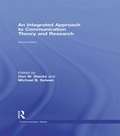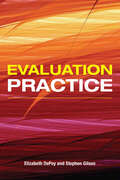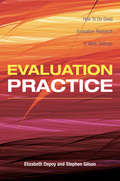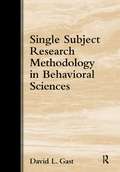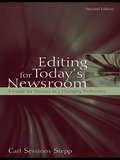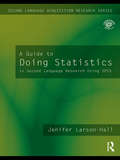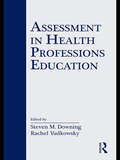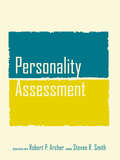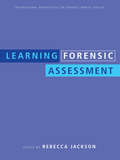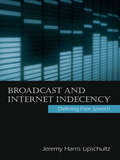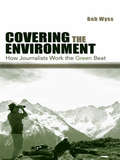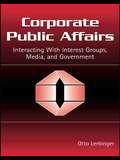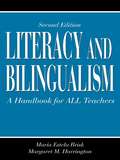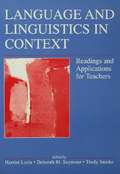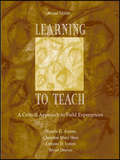- Table View
- List View
An Integrated Approach to Communication Theory and Research
by Don W. Stacks Michael B. SalwenThis volume provides an overview of communication study, offering theoretical coverage of the broad scope of communication study as well as integrating theory with research. To explicate the integration process, the chapter contributors -- experts in their respective areas -- offer samples in the form of hypothetical studies, published studies, or unpublished research, showing how theory and research are integrated in their particular fields. The book will appeal to graduate students and faculty members who want a thorough overview of not only the field, but also sample research stemming from its various component parts.
Evaluation Practice: How To Do Good Evaluation Research In Work Settings
by Elizabeth DePoy Stephen GilsonEvaluation Practice bridges the apparent gap between practice and research to present a logical, systematic model to guide all professional thinking and action within the context of everyday professional life. Their framework embraces diverse theories, action, and sets of evidence from a range of professional and disciplinary perspectives.
Evaluation Practice: How To Do Good Evaluation Research In Work Settings
by Elizabeth DePoy Stephen GilsonEvaluation Practice bridges the apparent gap between practice and research to present a logical, systematic model to guide all professional thinking and action within the context of everyday professional life. Their framework embraces diverse theories, action, and sets of evidence from a range of professional and disciplinary perspectives.
Single Subject Research Methodology in Behavioral Sciences
by Jennifer R. Ledford David L. GastThis book is written for student researchers, practitioners, and university faculty who are interested in answering applied research questions and objectively evaluating educational and clinical practices. The basic tenet of single-subject research methodology is that the individual is of primary importance and that each individual study participant serves as his or her own control. It is because of this focus on the individual that clinicians and educators have been using single-subject research designs for over 40 years to answer applied research questions. Although the methodology has its roots in behavioral psychology and applied behavioral analysis, it has been used by applied researchers across a variety of disciplines such as special education, speech and communication sciences, language and literacy, therapeutic recreation, occupational therapy, and social work. Key features include the following: Applied Focus – More than any other text, this one focuses on the nuts and bolts of how to use single-subject research in constructing one’s research project or in evaluating one’s professional practice. Numerous and Varied Examples – The book abounds in examples from special education and other disciplines and populations within the applied research literature. Reader Friendly – The text is written in a reader friendly style, features sample data sheets and graphic displays, and includes detailed guidelines for conducting visual analysis of graphic data. Expertise – The author’s long and distinguished career in teaching single-subject research is augmented in this book by contributions from other experts in the field.
Single Subject Research Methodology in Behavioral Sciences
by Jennifer R. Ledford David L. GastThis book is written for student researchers, practitioners, and university faculty who are interested in answering applied research questions and objectively evaluating educational and clinical practices. The basic tenet of single-subject research methodology is that the individual is of primary importance and that each individual study participant serves as his or her own control. It is because of this focus on the individual that clinicians and educators have been using single-subject research designs for over 40 years to answer applied research questions. Although the methodology has its roots in behavioral psychology and applied behavioral analysis, it has been used by applied researchers across a variety of disciplines such as special education, speech and communication sciences, language and literacy, therapeutic recreation, occupational therapy, and social work. Key features include the following: Applied Focus – More than any other text, this one focuses on the nuts and bolts of how to use single-subject research in constructing one’s research project or in evaluating one’s professional practice. Numerous and Varied Examples – The book abounds in examples from special education and other disciplines and populations within the applied research literature. Reader Friendly – The text is written in a reader friendly style, features sample data sheets and graphic displays, and includes detailed guidelines for conducting visual analysis of graphic data. Expertise – The author’s long and distinguished career in teaching single-subject research is augmented in this book by contributions from other experts in the field.
Editing for Today's Newsroom: A Guide for Success in a Changing Profession
by Carl Sessions SteppEditing for Today's Newsroom provides training, support and advice for prospective news editors. Through history, analyses, and anecdotes, this book offers a solid grounding to prepare potential editors for the full range of their responsibilities in today's newsrooms: developing ideas; evaluating and editing copy; working with writers; determining what is news; understanding presentation and design; directing news coverage; managing people; making decisions under pressure; and coping with a variety of ethical, legal, and professional considerations, all while operating in today’s multimedia, multiplatform news arena. Author Carl Sessions Stepp focuses on editors as newsroom decision makers and quality controllers; accordingly, the book features strategies and techniques for coping with a broad spectrum of editing duties. Covering basic and advanced copyediting skills, it also provides intellectual context to the editor's role, critically examining the history of editing and the changing job of the contemporary editor.
Editing for Today's Newsroom: A Guide for Success in a Changing Profession
by Carl Sessions SteppEditing for Today's Newsroom provides training, support and advice for prospective news editors. Through history, analyses, and anecdotes, this book offers a solid grounding to prepare potential editors for the full range of their responsibilities in today's newsrooms: developing ideas; evaluating and editing copy; working with writers; determining what is news; understanding presentation and design; directing news coverage; managing people; making decisions under pressure; and coping with a variety of ethical, legal, and professional considerations, all while operating in today’s multimedia, multiplatform news arena. Author Carl Sessions Stepp focuses on editors as newsroom decision makers and quality controllers; accordingly, the book features strategies and techniques for coping with a broad spectrum of editing duties. Covering basic and advanced copyediting skills, it also provides intellectual context to the editor's role, critically examining the history of editing and the changing job of the contemporary editor.
A Guide to Doing Statistics in Second Language Research Using SPSS
by Jenifer Larson-HallThis valuable book shows second language researchers how to use the statistical program SPSS to conduct statistical tests frequently done in SLA research. Using data sets from real SLA studies, A Guide to Doing Statistics in Second Language Research Using SPSS shows newcomers to both statistics and SPSS how to generate descriptive statistics, how to choose a statistical test, and how to conduct and interpret a variety of basic statistical tests. It covers the statistical tests that are most commonly used in second language research, including chi-square, t-tests, correlation, multiple regression, ANOVA and non-parametric analogs to these tests. The text is abundantly illustrated with graphs and tables depicting actual data sets, and exercises throughout the book help readers understand concepts (such as the difference between independent and dependent variables) and work out statistical analyses. Answers to all exercises are provided on the book’s companion website, along with sample data sets and other supplementary material.
A Guide to Doing Statistics in Second Language Research Using SPSS
by Jenifer Larson-HallThis valuable book shows second language researchers how to use the statistical program SPSS to conduct statistical tests frequently done in SLA research. Using data sets from real SLA studies, A Guide to Doing Statistics in Second Language Research Using SPSS shows newcomers to both statistics and SPSS how to generate descriptive statistics, how to choose a statistical test, and how to conduct and interpret a variety of basic statistical tests. It covers the statistical tests that are most commonly used in second language research, including chi-square, t-tests, correlation, multiple regression, ANOVA and non-parametric analogs to these tests. The text is abundantly illustrated with graphs and tables depicting actual data sets, and exercises throughout the book help readers understand concepts (such as the difference between independent and dependent variables) and work out statistical analyses. Answers to all exercises are provided on the book’s companion website, along with sample data sets and other supplementary material.
Assessment in Health Professions Education
by Steven M. Downing Rachel YudkowskyAssessment in Health Professions Education provides comprehensive guidance for persons engaged in the teaching and testing of the health professions – medicine, dentistry, nursing, pharmacy and allied fields. Part I of the book provides a user-friendly introduction to assessment fundamentals and their theoretical underpinnings; Part II describes specific assessment methods used in the health professions, with a focus on best practices, assessment challenges, and practical guidelines for the effective implementation of successful assessment programs. Key features: Comprehensive – the first text to provide broad, single-source coverage of all aspects of assessment in the health professions. Accessible – while scholarly and evidence-based, the book is geared towards health professions educators who are not measurement specialists. Thematic – assessment validity is an organizing theme and provides a conceptual framework throughout the book.
Assessment in Health Professions Education
by Steven M. Downing Rachel YudkowskyAssessment in Health Professions Education provides comprehensive guidance for persons engaged in the teaching and testing of the health professions – medicine, dentistry, nursing, pharmacy and allied fields. Part I of the book provides a user-friendly introduction to assessment fundamentals and their theoretical underpinnings; Part II describes specific assessment methods used in the health professions, with a focus on best practices, assessment challenges, and practical guidelines for the effective implementation of successful assessment programs. Key features: Comprehensive – the first text to provide broad, single-source coverage of all aspects of assessment in the health professions. Accessible – while scholarly and evidence-based, the book is geared towards health professions educators who are not measurement specialists. Thematic – assessment validity is an organizing theme and provides a conceptual framework throughout the book.
Personality Assessment
by Robert P. Archer Steven R. SmithPersonality Assessment provides an overview of the most popular self-report and performance-based personality assessment instruments. Designed with graduate-level clinical and counseling psychology programs in mind, the book serves as an instructional text for courses in objective or projective personality assessment. It provides coverage of eight of the most popular assessment instruments used in the United States—from authors key in creating, or developing the research base for these test instruments. The uniquely informed perspective of these leading researchers, as well as chapters on clinical interviewing, test feedback, and integrating test results into a comprehensive report, will offer students and clinicians a level of depth and complexity not available in other texts.
Personality Assessment
by Robert P. Archer Steven R. SmithPersonality Assessment provides an overview of the most popular self-report and performance-based personality assessment instruments. Designed with graduate-level clinical and counseling psychology programs in mind, the book serves as an instructional text for courses in objective or projective personality assessment. It provides coverage of eight of the most popular assessment instruments used in the United States—from authors key in creating, or developing the research base for these test instruments. The uniquely informed perspective of these leading researchers, as well as chapters on clinical interviewing, test feedback, and integrating test results into a comprehensive report, will offer students and clinicians a level of depth and complexity not available in other texts.
Learning Forensic Assessment
by Rebecca JacksonProviding an excellent resource for forensic psychology undergraduate students, this book offers students the opportunity to learn from experts, through the collection of outstanding articles. Unlike other books in the area that are topic specific, it also gives them comprehensive coverage of the subject. Divided into five broad topic areas, it covers: professional issues juvenile assessment criminal forensic assessment civil forensic assessment pervasive issues – malingering and psychopathy. Written by a group of internationally renowned contributors and including didactic information as well as providing discussions on practical issues regarding assessment and assessment instruments, this textbook will be invaluable reading for all students of forensic psychology.
Learning Forensic Assessment
by Rebecca JacksonProviding an excellent resource for forensic psychology undergraduate students, this book offers students the opportunity to learn from experts, through the collection of outstanding articles. Unlike other books in the area that are topic specific, it also gives them comprehensive coverage of the subject. Divided into five broad topic areas, it covers: professional issues juvenile assessment criminal forensic assessment civil forensic assessment pervasive issues – malingering and psychopathy. Written by a group of internationally renowned contributors and including didactic information as well as providing discussions on practical issues regarding assessment and assessment instruments, this textbook will be invaluable reading for all students of forensic psychology.
Broadcast and Internet Indecency: Defining Free Speech
by Jeremy LipschultzIndecency--arguably among the most provocative and incendiary issues in today's media--is speech at the edge of social tolerance. This timely volume examines broadcast and Internet indecency from legal and social perspectives, utilizing current cases and well-publicized examples. In exploring the issues associated with this highly controversial area, author Jeremy Harris Lipschultz makes headway toward an understanding of how indecency, as communication on the fringes of social norms, functions in defining free expression through specific types of speech. He contrasts conceptualizations of indecency and obscenity, synthesizes case law and social research, and develops theoretical generalizations for future research and study. His work provides a comprehensive examination of broadcast and Internet indecency issues and cases that serve to test generalizations about freedom of expression and one's ability to define free speech.
Broadcast and Internet Indecency: Defining Free Speech
by Jeremy LipschultzIndecency--arguably among the most provocative and incendiary issues in today's media--is speech at the edge of social tolerance. This timely volume examines broadcast and Internet indecency from legal and social perspectives, utilizing current cases and well-publicized examples. In exploring the issues associated with this highly controversial area, author Jeremy Harris Lipschultz makes headway toward an understanding of how indecency, as communication on the fringes of social norms, functions in defining free expression through specific types of speech. He contrasts conceptualizations of indecency and obscenity, synthesizes case law and social research, and develops theoretical generalizations for future research and study. His work provides a comprehensive examination of broadcast and Internet indecency issues and cases that serve to test generalizations about freedom of expression and one's ability to define free speech.
Covering the Environment: How Journalists Work the Green Beat
by Robert L. WyssCovering the Environment serves as a primer for future and current journalists reporting on environmental issues across all types of media. This practical resource explains the primary issues in writing on the environment, identifies who to go to and where to find sources, and offers examples on writing and reporting the beat. It also provides background to help environmental journalists identify their audiences and anticipate reactions to environmental news. This primer emphasizes the role of environmental journalists not as environmental advocates but as reporters attempting to accurately and fairly report the news. Contents include: An overview and history of the environment and journalism, spotlighting the most significant issues in the beat Guidance on understanding environmental and health science, ranging from issues of risk, to scientific research and studies, to interviewing scientists Insights into government and regulatory communities and environmental advocates on all sides of the political spectrum Assistance in accessing public records and conducting computer-assisted reporting Guidance in writing the story for print, broadcast and Internet audiences An examination of the future of journalism and coverage of the environment. Observations and story excerpts from experienced journalists provide a "real world" component, illuminating the practice of environmental journalism. Additional features in each chapter include study questions, story assignments and resources for additional information. The book also provides a glossary of environmental, science, regulator and journalism terms, as well as a reference section and index. This resource has been developed to train advanced undergraduate and graduate journalism students to cover the science and environment community, writing print and broadcast stories to a general audience. It also serves as a guide for working journalists who cover the environment in their work.
Corporate Public Affairs: Interacting With Interest Groups, Media, and Government
by Otto LerbingerCorporate Public Affairs explores the increasing interest in public affairs by today's organizations. Lerbinger indicates that more and more frequently corporations are establishing public affairs positions--typically within public relations departments--to respond to issues and concerns arising out of the sociopolitical environment in which the corporation functions. He articulates the functions and responsibilities of the public affairs role, and investigates the approaches to dealing with primary constituencies--interest groups, media, and government.Divided into five parts, this book:*provides an overview of the corporate public affairs function;*explores strategies of the myriad interest groups in the United States, such as labor unions and environmental, consumer, women's, and human rights groups;*recognizes the media's increasing coverage of business events, especially negative ones, that have tremendous power both to undermine corporate credibility and to support public policy positions;* deals with legislative, executive, and judicial branches of government; and*raises the question of how corporate power strategies have affected the political marketplace.This book will appeal to advanced-level students, scholars, and practitioners in public relations and business fields.
Corporate Public Affairs: Interacting With Interest Groups, Media, and Government
by Otto LerbingerCorporate Public Affairs explores the increasing interest in public affairs by today's organizations. Lerbinger indicates that more and more frequently corporations are establishing public affairs positions--typically within public relations departments--to respond to issues and concerns arising out of the sociopolitical environment in which the corporation functions. He articulates the functions and responsibilities of the public affairs role, and investigates the approaches to dealing with primary constituencies--interest groups, media, and government.Divided into five parts, this book:*provides an overview of the corporate public affairs function;*explores strategies of the myriad interest groups in the United States, such as labor unions and environmental, consumer, women's, and human rights groups;*recognizes the media's increasing coverage of business events, especially negative ones, that have tremendous power both to undermine corporate credibility and to support public policy positions;* deals with legislative, executive, and judicial branches of government; and*raises the question of how corporate power strategies have affected the political marketplace.This book will appeal to advanced-level students, scholars, and practitioners in public relations and business fields.
Literacy and Bilingualism: A Handbook for ALL Teachers
by Maria Estela Brisk Margaret M. HarringtonThis handbook applies proven techniques, derived from bilingual/bicultural classrooms, to teaching literacy in the twenty-first century. Its goal is to help teachers increase their understanding of bilingual learners in order to maximize instruction. Teachers can use this handbook to expand their understanding of literacy and bilingualism; implement literacy approaches and assess students’ development; and learn through reflection. Practical, flexible format and content. Complete and straightforward instructions, illustrated by case studies, allow teachers to use the strategies in this handbook on their own or in teacher-led study groups. They can select from the variety of approaches the ones which best match their students’ needs and their own teaching style. Student-centered focus. All of the approaches share characteristics that help motivate students of varying language abilities to develop literacy. Field-tested approaches. The approaches have been modified and tested with bilingual students of different ages and language backgrounds in bilingual, ESL, mainstream, special education, and deaf education classes ranging from preschool through high school. New in the Second Edition: *five new approaches with their corresponding classroom implementation;*additional information in each introduction addressing its theme;*new material on issues of language, culture, and literacy development of students completely new to the English language; and*annotated bibliographies with sample books to support literacy within language and content area classes. Literacy and Bilingualism is intended for a broad audience of teachers in any type of classroom where bilingualism plays a role, and is an excellent text for preservice and inservice courses that prepare teachers to work with English language learners.
Literacy and Bilingualism: A Handbook for ALL Teachers
by Maria Estela Brisk Margaret M. HarringtonThis handbook applies proven techniques, derived from bilingual/bicultural classrooms, to teaching literacy in the twenty-first century. Its goal is to help teachers increase their understanding of bilingual learners in order to maximize instruction. Teachers can use this handbook to expand their understanding of literacy and bilingualism; implement literacy approaches and assess students’ development; and learn through reflection. Practical, flexible format and content. Complete and straightforward instructions, illustrated by case studies, allow teachers to use the strategies in this handbook on their own or in teacher-led study groups. They can select from the variety of approaches the ones which best match their students’ needs and their own teaching style. Student-centered focus. All of the approaches share characteristics that help motivate students of varying language abilities to develop literacy. Field-tested approaches. The approaches have been modified and tested with bilingual students of different ages and language backgrounds in bilingual, ESL, mainstream, special education, and deaf education classes ranging from preschool through high school. New in the Second Edition: *five new approaches with their corresponding classroom implementation;*additional information in each introduction addressing its theme;*new material on issues of language, culture, and literacy development of students completely new to the English language; and*annotated bibliographies with sample books to support literacy within language and content area classes. Literacy and Bilingualism is intended for a broad audience of teachers in any type of classroom where bilingualism plays a role, and is an excellent text for preservice and inservice courses that prepare teachers to work with English language learners.
Language and Linguistics in Context: Readings and Applications for Teachers
by Harriet Luria Deborah M. Seymour Trudy SmokeTaking a sociocultural and educational approach, Language and Linguistics in Context: Readings and Applications for Teachers:*introduces basic linguistic concepts and current perspectives on language acquisition;*considers the role of linguistic change (especially in English) in the politics of language;*acknowledges the role of linguists in current policies involving language; *offers insights into the relationship between the structure of language systems and first- and second-language acquisition; the study of language across culture, class, race, gender, and ethnicity; and between language study and literacy and education; and*provides readers with a basis for understanding current educational debates about bilingual education, non-standard dialects, English only movements, literacy methodologies, and generally the importance to teaching of the study of language. The text is organized into three thematic units – "What is Language and How is It Acquired?"; "How Does Language Change?"; and "What is Literacy?". To achieve both breadth and depth – that is, to provide a “big picture” view of basic linguistics and at the same time make it specific enough for the beginner – a selection of readings, including personal language narratives, is provided to both introduce and clarify linguistic concepts. The readings, by well-known theoretical and applied linguists and researchers from various disciplines, are diverse in level and range of topics and vary in level of linguistic formalism. Pedagogical features: This text is designed for a range of courses in English and language arts, bilingualism, applied linguistics, and ESL courses in teacher education programs. Each unit contains a substantive introduction to the topic, followed by the readings. Each reading concludes with Questions to Think About including one Extending Your Understanding question, and a short list of Terms to Define. Each unit ends with additional Extending Your Understanding and Making Connections activities that engage readers in applying what they have read to teaching and suggested projects and a bibliography of Print and Web Resources. The readings and apparatus are arranged so that the material can be modified to fit many course plans and schemes of presentation. To help individual instructors make the most effective use of the text in specific classes, a set of matrixes is provided suggesting configurations of readings for different types of linguistics and education classes.
Language and Linguistics in Context: Readings and Applications for Teachers
by Harriet Luria Deborah M. Seymour Trudy SmokeTaking a sociocultural and educational approach, Language and Linguistics in Context: Readings and Applications for Teachers:*introduces basic linguistic concepts and current perspectives on language acquisition;*considers the role of linguistic change (especially in English) in the politics of language;*acknowledges the role of linguists in current policies involving language; *offers insights into the relationship between the structure of language systems and first- and second-language acquisition; the study of language across culture, class, race, gender, and ethnicity; and between language study and literacy and education; and*provides readers with a basis for understanding current educational debates about bilingual education, non-standard dialects, English only movements, literacy methodologies, and generally the importance to teaching of the study of language. The text is organized into three thematic units – "What is Language and How is It Acquired?"; "How Does Language Change?"; and "What is Literacy?". To achieve both breadth and depth – that is, to provide a “big picture” view of basic linguistics and at the same time make it specific enough for the beginner – a selection of readings, including personal language narratives, is provided to both introduce and clarify linguistic concepts. The readings, by well-known theoretical and applied linguists and researchers from various disciplines, are diverse in level and range of topics and vary in level of linguistic formalism. Pedagogical features: This text is designed for a range of courses in English and language arts, bilingualism, applied linguistics, and ESL courses in teacher education programs. Each unit contains a substantive introduction to the topic, followed by the readings. Each reading concludes with Questions to Think About including one Extending Your Understanding question, and a short list of Terms to Define. Each unit ends with additional Extending Your Understanding and Making Connections activities that engage readers in applying what they have read to teaching and suggested projects and a bibliography of Print and Web Resources. The readings and apparatus are arranged so that the material can be modified to fit many course plans and schemes of presentation. To help individual instructors make the most effective use of the text in specific classes, a set of matrixes is provided suggesting configurations of readings for different types of linguistics and education classes.
Learning to Teach: A Critical Approach to Field Experiences
by Natalie G. Adams Christine Mary Shea Delores D. Liston Bryan DeeverThis text is designed to assist preservice and inservice teachers in creating a critical and reflective dialogue with themselves, their assigned classroom cultures, and the larger school environment. It engages readers in a series of classroom and school-based activities, observations, and exercises that can be used in any teacher education course with a field component. Different from other field experience guides, this text aims to disrupt traditional conceptions of teacher education and field experiences--by emphasizing the problematic nature and dynamics of public schooling, and encouraging readers to seek a greater awareness of their own attitudes toward and connections with these educational processes.Learning to Teach: A Critical Approach to the Field Experience, Second Edition:*dramatically reconceptualizes the field experience by asking preservice and inservice teachers to be active and critical researchers of classroom practices and processes;*provides a coherent framework for analyzing both structural and cultural aspects of schooling;*provides specific exercises to help preservice and inservice teachers evaluate and understand the intersections of race, class, gender, and culture in "real life" school settings; and*grounds the observations of everyday school life within critical, feminist, and poststructuralist discourses.New in the Second Edition: A new section,"No Child Left Untested," has been added to help preservice teachers explore the implications of a very changed post-September 11world in which xenophobia, violence, patriotism, citizenship, and democracy have taken on new meanings. The introduction to the book as a whole, the section introductions, the retained activities in existing sections, and the references have been throughly updated.
